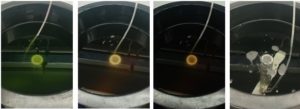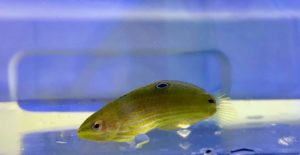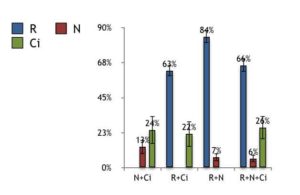
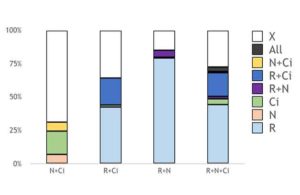
At the University of Florida Indian River Research and Education Center in Fort Pierce, FL we have been examining food preference for blue tang larvae. We fed them copepods Parvocalanus crassirostris, rotifers Brachionus rotundiformis and ciliates Euplotes sp. But how do we know which they eat? We have begun using fluorescent microspheres (Fig. 1) to label each different food item – red for copepods, blue for rotifers, and green for the ciliates. After feeding, the larvae are placed under a special scope and based on the colors in their gut we can tell what they ate.
The ciliate Euplotes spp. can be grown at very high densities (up to 12,000 / mL), can be enriched, do not have any protective layer, and have a very small effective size (can fit through a 23 micron sieve). Initial results are promising as ciliates have been confirmed to be ingested by Pacific blue tang (Paracanthurus hepatus), reef butterflyfish (Chaetodon sedentarius) and mono (Mono sebae) larvae within a few hours of introduction.
Larval Pacific blue tang (Paracanthurus hepatus) preference trials were performed using the following treatments:
- nauplii and ciliates
- rotifers and ciliates
- rotifers and nauplii
- all three food types.
Trials were performed on 3 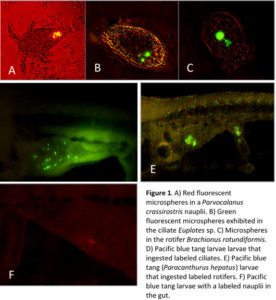 day post hatch larvae which is their first feeding. Blue tang larvae seem to have a strong preference for rotifers under the experimental conditions while ciliates and nauplii were shown to be eaten at a lower level. It is interesting to note that regardless of the concentration of total food prey items which was higher in the last treatment with all three food types, ingestion rates were not significantly different. However, it is important to take into consideration that ciliates may be digested anywhere from 2-5 times faster than a rotifer and nauplii. This is further complicated due to the unknown residence time of microspheres inside the larval gut. More research is needed but microspheres are clearly a useful tool to define what a larval fish is eating and to identify shifts in live food preferences at different stages of development.
day post hatch larvae which is their first feeding. Blue tang larvae seem to have a strong preference for rotifers under the experimental conditions while ciliates and nauplii were shown to be eaten at a lower level. It is interesting to note that regardless of the concentration of total food prey items which was higher in the last treatment with all three food types, ingestion rates were not significantly different. However, it is important to take into consideration that ciliates may be digested anywhere from 2-5 times faster than a rotifer and nauplii. This is further complicated due to the unknown residence time of microspheres inside the larval gut. More research is needed but microspheres are clearly a useful tool to define what a larval fish is eating and to identify shifts in live food preferences at different stages of development.


